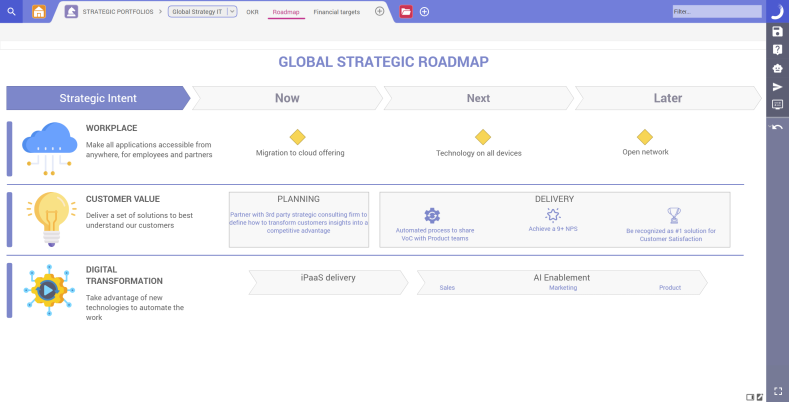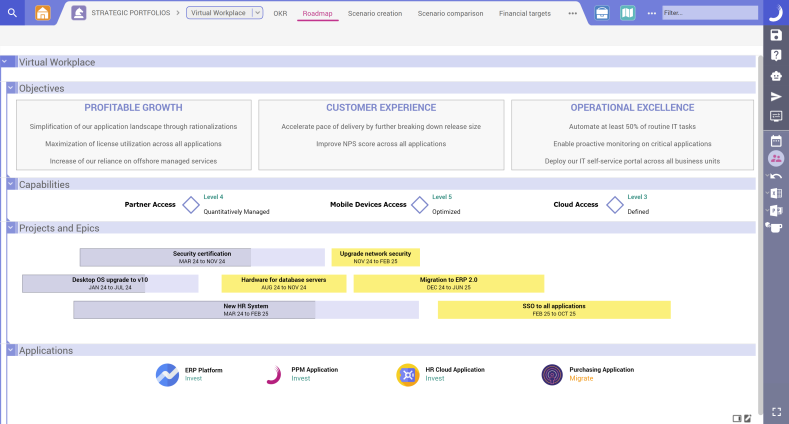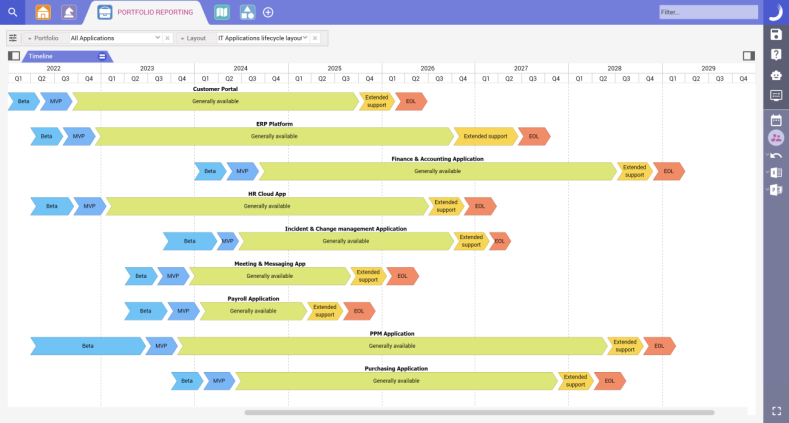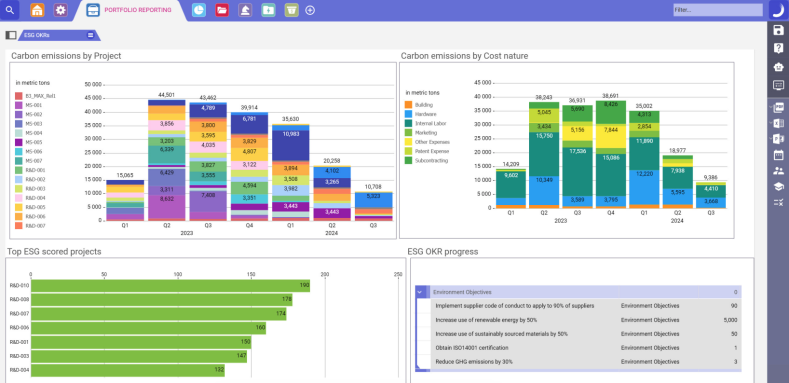This guide is a collection of insights aimed at ensuring your IT roadmapping and digital transformation initiatives are a resounding success.
What is an IT roadmap?
An IT roadmap is a highly-visual, forward-looking, strategic-level blueprint of your organization’s short- and long-term IT plans, objectives, and structures. It is used to demonstrate a strategy to stakeholders, keep them updated on project progress, and support discussions about reprioritization.
IT roadmaps centralize your IT projects and chart your organization’s journey through digital transformation initiatives, ensuring alignment with broader strategic objectives. An IT roadmap could include projects such as the introduction of new technologies like artificial intelligence, or updates and optimizations to existing systems.
IT roadmaps support strategic planning, technology implementation, and business alignment. Some types include enterprise IT roadmaps, IT project roadmaps, and IT architecture roadmaps, which can at a basic level be differentiated as follows:
- Enterprise IT roadmaps are high-level and detail a range of campaigns and initiatives that support overarching company objectives.
- IT project roadmaps provide a strategic-level overview of the progress of one or more specific IT-related projects.
- IT architecture roadmaps represent how an organization’s software systems align with capabilities and strategic goals.
No two IT roadmaps will look the same—they are tailored to each organization’s needs. You may communicate the progress of the initiatives through color coding or their order on the roadmap, such as complete, in testing, on track, at risk, and off track. A roadmap may also detail the order of strategic importance of the initiatives to an organization. Some may be essential, others nice to have.
IT roadmaps differ from product roadmaps in that they are concerned with your internal systems and processes, rather than any initiatives that interact with your customers or market, such as with product launches and updates.



What are the benefits of IT roadmapping?
By establishing a clear strategic direction and a comprehensive view of all initiatives and operations, IT roadmaps play a crucial role in driving IT transformation. They provide value in several key areas:
- Strategy: A strategic vantage point helps IT leaders to pinpoint potential risks or inefficiencies. These insights support decisions to redeploy resources in a more meaningful, strategically-aligned way. This saves money and boosts efficiency.
- Communication: Roadmaps help you build a clear, compelling case to internal stakeholders for the route you’ll take to achieve the organization’s strategic vision.
- Alignment: An IT roadmap provides internal teams with instant insights into their strategic responsibilities to the business, ensuring technologies and systems run smoothly and effectively.
Check out our webinar, The Case for Using Roadmaps, to learn more about how organizations can use integrated roadmaps to coordinate around strategic objectives.
How SPM tools help with IT roadmapping
Strategic portfolio management (SPM) tools are the place to start when creating an IT roadmap for your organization. These solutions provide you with access to a range of dynamic, multi-layered roadmap templates and a range of features to help accelerate and optimize the roadmapping process, including:
1. Generative AI
CIOs can also deploy artificial intelligence to analyze past roadmaps in combination with organizational priorities and other historical project data to automatically populate your roadmap, using logical reasoning to fill any gaps.
With the click of a button, you can intelligently populate your IT roadmap with preliminary project goals, project milestones, timelines, and projected ROI. Not only does it accelerate the creation phase of your IT roadmapping process, but it also enables greater consistency.
2. AI predictive analytics
This uses predictive modeling, a statistical technique for analyzing historical project, program, or portfolio data and predicting outcomes for investments with similar drivers or parameters—a highly valuable use case for CIOs.
You benefit from faster trend and pattern recognition and more accurate predictions (if you have high-quality data.) Being able to predict completion dates, budgets, risks, and ROI with greater certainty means you can confidently progress your IT roadmap.
3. Particle swarm optimization (PSO)
Rationalizing your IT roadmap against existing or future resources and capacity could entail weeks of planning meetings. Here, particle swarm optimization can help.
This plays out as an AI-driven algorithm that controls for all possible variables and solutions to develop the most optimal allocation of resources for your roadmap. If you want to see the algorithm in action in an actual software setting, watch our PSO demo video.
4. Online collaboration
For your roadmapped projects to become a reality, you’ll still need buy-in and approval from key stakeholders. Previously, this could have been a fragmented, frustrating process using legacy spreadsheet software, with comments and changes lost due to poor version control.
SPM and PPM tools can help you to create a single source of truth, making it easier to keep track of changes and review roadmap and feedback cycles. Watch our integrated roadmap webinar to see how we do it at Planisware.
5. Plug-and-play dashboards
IT roadmapping is a continuous process, and building dashboards can be time consuming. By furnishing you with a range of intuitive dashboards, SPM tools can bridge the gap, helping you to make effective decisions even in the face of a new strategic direction.
When combined with a single source of truth tool for your projects, programs, and portfolios, you have all the live, strategic oversight you need to successfully adapt your IT roadmap.
How to prioritize return-on-investment (ROI) in your IT roadmap
There’s a tightrope for CIOs to walk when creating roadmaps: balancing leadership enthusiasm for new technologies with realistic return-on-investment (ROI) projections.
A survey revealed that 47% of CEOs are prioritizing tech investments, including artificial intelligence (AI), to improve growth and productivity in the next 12 months. Yet at the same time, the majority of CIOs are struggling to demonstrate these projects’ ROI and 42% expect no positive ROI from AI investments for 2-3 years. According to an IDC survey, 3 in 10 CIOs do not know if their AI proof-of-concepts were considered successful or met KPI metrics.
This shows how much of a delicate balancing act IT roadmapping is for CIOs. You need to demonstrate an innovation focus, while ensuring tech investments deliver long-term value and move the needle on organizational goals. At the same time, there’s the need to reconcile this high-level view with grounded resource allocation and capabilities.
1. Review your business goals, IT landscape, and proposed tech investments
Put your business goals in the spotlight. While some might reference digital transformation or even AI enablement, these goals can lack clear strategic value. Those with a sharper focus, however, might emphasize areas such as:
- market expansion
- employee productivity
- customer satisfaction
- cost efficiencies
These types of goals are your starting point for scrutinizing the tech investments comprising your strategic IT technology roadmap. In other words, if the technology or application won’t drive your organization toward its current goals—like data integration would improve information silos—it’s not a priority candidate for investment.
Take ADM, for example. After a series of mergers and acquisitions led to a complex landscape of tools and data, they realized the benefits of standardizing their information using an enterprise SPM tool, creating a single source of truth for IT projects and assets to support digital innovation.
Then there’s the example of TotalEnergies, a French multinational integrated energy and petroleum company. Its goal to transform into a multi-energy company fueled a decision to invest in an SPM tool to streamline all investments into a single source of truth. As a result, the company strategically optimized resource allocation for its expanded and diversified portfolio.
After reviewing your business goals, as we've seen with the examples above, you’re in a position to evaluate your tech investments, assessing each based on its business-specific ROI and risk before it becomes part of your IT technology roadmap.
Factors such as organizational readiness for new technologies and industry use cases will determine project success. In life sciences, for instance, companies might use AI analytics to more quickly and accurately identify relevant products for their patients. Predictive algorithms can also have a transformative impact on project planning in pharma, for example.
As part of your risk assessment, you’ll also need to consider how market conditions, competitive pressures, and budget constraints might impact individual investments. You can start with a typical risk matrix to map likelihood and effect, but it’s also worth using McKinsey’s approach to dynamic risk management to future-proof your roadmap against risks.
Sustainable technology practices
ESG should not be seen simply as a compliance exercise, but also an opportunity to drive innovation, competitive advantage, and better ROI. Sustainable technology practices are a critical component of any modern digital transformation program.
Many businesses are increasingly investing in cloud services, green data centers, and more energy-efficient hardware to reduce their environmental footprint. Take hardware circularity, for example. As of 2024, only 1 in 5 executive leaders are investing in refurbished assets.
Tracking and reporting on ESG metrics through integrated dashboards is another essential step to ensuring alignment with sustainability business goals.

2. Identify your stakeholders and define their priorities
An IT technology roadmap serves a crucial purpose beyond implementation planning—it’s also a key communication tool for aligning cross-functional stakeholders and your executive leadership team on tech investments.
An effective roadmap will highlight information that resonates with each stakeholder group, providing both a top-level strategic view and a detailed drill-down for individual projects.
Start the roadmapping process by identifying your stakeholders, whether from finance, operations, or your executive team. Then, map their priorities to aspects of the roadmap, such as project budget and ROI for your finance team and expected productivity improvements for operations.
Tailoring your roadmap to their drivers in this way will improve buy-in, foster a shared understanding across teams, and reduce resistance to change.
3. Optimize the process with SPM tools
Identifying and prioritizing strategically critical projects is a big challenge. This can be made more difficult due to the fact that IT roadmapping can be time-consuming. As a CIO, you may not have the luxury of devoting extensive resources to this process. Fortunately, the process can be simplified with strategic portfolio management (SPM) tools, which provide access to features like:
- Dedicated roadmapping tools, making it easier and faster to build your roadmap, collect and manage feedback, and impact test different scenarios. Dynamic, connected, multi-layered templates can be easily edited and quickly populated to suit your needs.
- AI optimizations and insights, including chatbots, what-if scenario simulations, and predictive analytics. This improves speed, consistency, and accuracy when creating roadmaps compared to legacy methods, accelerating project prioritization, budget and resource planning, and work breakdown structures (WBS).
- Powerful and customizable dashboards, offering a comprehensive 360° view of projects, resources, and outcomes to help in planning and monitoring your roadmap.
As a CIO guiding an organization through digital transformation, you may feel as though you are contending with an ever-expanding portfolio of applications and tools. It can be fairly daunting.
Application portfolio management (APM) addresses this by providing a strategic framework to assess, optimize, and rationalize applications across the organization. Effective APM ensures that you allocate your resources to the most valuable applications and decommission redundant or underperforming legacy systems.
A robust APM strategy not only improves operational efficiency but also reduces costs and enhances system interoperability, as we discussed earlier. Additionally, it helps identify gaps in your technology stack, enabling better alignment between IT investments and business goals.
Factors affecting the success of your IT roadmap
To set yourself and your IT roadmap up for success, it’s critical to prioritize four key factors: relevance, feasibility, culture, and change management.
1. Relevance
As we’ve mentioned, a review of your business goals, IT landscape, and tech investments is essential for getting key decision-makers on board with your roadmap and ensuring it is seen to drive both short- and long-term value.
That being said, your roadmap needs to capture more than just executive-level ambitions. To drive cross-functional alignment from an early stage, set up discussions with stakeholders to talk about their immediate and anticipated IT needs. These may include:
- headcount growth or cuts
- budget growth or cuts
- innovation projects
- competitor investments
With the help of SPM tools, CIOs and other IT leaders can capture, filter, and align all stakeholder input on the IT roadmap in a single view to effectively and efficiently assess relevance.
2. Feasibility
Taking an ambitious approach to your IT roadmap is a surefire way to engage stakeholders. But, as a CIO or IT leader, you also need to deliver on those promises to maintain confidence in your abilities, particularly if you’re new to the role.
By anchoring your roadmap in your current IT capabilities and available resources, you’ll set yourself and your teams up for success.
To ensure your roadmap is realistic, collaborate with executive and functional leaders to conduct a deep dive into your current infrastructure and evaluate the impact of factors such as:
- legacy systems
- shadow IT
- resource allocation for current and future projects
- in-house and external partner capabilities
This task may seem daunting, particularly if your company’s growth is the result of a merger or acquisition, each with their own IT infrastructure and processes.
3. Culture
Successful digital transformation is as much about people as it is about the right technology investments. The overall effectiveness of your IT roadmap will largely depend on your organizational culture, particularly how readily teams adopt new technologies.
This all means working with department stakeholders to understand localized attitudes and behaviors toward technology. Armed with this knowledge, you can pinpoint teams with additional training and support requirements compared to those ready and willing to adopt something new.
If your culture requires network effects, critical mass, or even internal success stories to adopt new technologies, you could stagger implementation by function for some projects.
French retail giant Monoprix took this approach with an integrated SPM tool, starting with Information Systems, Organization, and Technical Security and Safety. The result was a remarkable 50% performance increase in project planning and tracking.
Hybrid workforce optimization
In recent years, a key consideration in the IT strategy of CIOs has been the emergence of the hybrid workforce. Balancing in-office and remote work models can benefit both employee wellbeing and operational costs, but barriers to productivity and collaboration can exist.
Investing in technology that enables online communication, efficient workflows, and a single source of truth for projects and remote teams should be a clear priority, if it isn’t already.
The hybrid model works best when employees feel empowered, connected, and supported, regardless of where they work. Take a look at how Jazz Pharmaceuticals implemented Planisware to boost compliance, innovation, and employee work-life balance.
4. Change management
Strong business cases and solid stakeholder management will set you and your IT roadmap up for success. But to fully realize the benefits of your preparation, efficiently deliver projects, and maximize the ROI of your investments, you also need a change management plan.
This should include:
- Check-ins with implementation teams: Your IT teams will often have to continue business-as-usual or other ongoing projects while they work on digital transformation. Regular check-ins help gauge their level of fatigue and give you the opportunity to collaborate with the rest of your C-suite to renegotiate timelines or resources if necessary.
- C-suite engagement: Briefing your C-suite peers on the strategic value of your roadmap and any new technologies is, of course, essential, but don’t stop there. Set up regular opportunities for them to review progress and ask questions to avoid setbacks caused by a lack of confidence.
- KPI reporting: Before launching your enterprise IT roadmap, establish a clear, regularly updated view of your projects’ performance. Creating a single source of truth with real-time dashboards allows you to quickly see the impact of project changes and make smarter decisions in response, like Zebra Technologies discovered when they implemented Planisware.
Revolutionize your roadmapping and drive digital transformation with Planisware
Planisware’s solutions help CIOs and IT leaders gain 360°, real-time visibility of an organization’s initiatives and empower them to drive digital transformation.
With a range of features, our SPM and PPM solutions can handle time-consuming, manual aspects of your IT roadmapping process, allowing you to shift your focus to what matters most. Our connected, multi-layered roadmaps are visually-compelling, dynamic, and driven by real data, helping you to align your strategic vision with actionable details.
Book a one-to-one live demo today to discover how Planisware can help you to drive innovation and deliver results as an IT leader.


